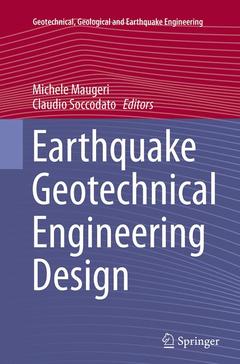Description
Earthquake Geotechnical Engineering Design, 2014
Geotechnical, Geological and Earthquake Engineering Series, Vol. 28
Coordinators: Maugeri Michele, Soccodato Claudio
Language: English
Subjects for Earthquake Geotechnical Engineering Design:
Publication date: 09-2016
Support: Print on demand
Publication date: 03-2014
388 p. · 15.5x23.5 cm · Hardback
Description
/li>Contents
/li>Comment
/li>
Pseudo-static analysis is still the most-used method to assess the stability of geotechnical systems that are exposed to earthquake forces. However, this method does not provide any information about the deformations and permanent displacements induced by seismic activity. Moreover, it is questionable to use this approach when geotechnical systems are affected by frequent and rare seismic events. Incidentally, the peak ground acceleration has increased from 0.2-0.3 g in the seventies to the current value of 0.6-0.8 g. Therefore, a shift from the pseudo-static approach to performance-based analysis is needed.
Over the past five years considerable progress has been made in Earthquake Geotechnical Engineering Design (EGED). The most recent advances are presented in this book in 6 parts.
The evaluation of the site amplification is covered in Part I of the book. In Part II the evaluation of the soil foundation stability against natural slope failure and liquefaction is treated. In the following 3 Parts of the book the EGED for different geotechnical systems is presented as follows: the design of levees and dams including natural slopes in Part III; the design of foundations and soil structure interaction analysis in Part IV; underground structures in Part V. Finally in Part VI, new topics like the design of reinforced earth retaining walls and landfills are covered.
Spatially constrained inversion of surface wave data to build shear wave velocity models.- Site Classification and spectral amplification for seismic code provisions.- Sand Liquefaction observed during Recent earthquake and Basic Laboratory Studies on Aging effect.-
Liquefaction In Tokyo Bay And Kanto Regions In The 2011 Great East Japan Earthquake.- Allowable settlement and inclination of houses defined after the 2011 Tohoku - Pacific Ocean Earthquake in Japan.- Seismic Performance of River Levees; Experience and Prediction.- Earthquake Performance Design of Dams using Destructive Potential Factors.- Seismic response of shallow footings: a promising application for the macro-element approach.- Large-Scale Modeling of Ground and Soil-Structure Earthquake Response.- Seismic displacement based design of structures: relevance of soil structure interaction.- Performance and seismic design of underground structures.- Reinforced Soil Walls during the Recent Great Earthquakes in Japan and Geo-Risk based Design.- Performance Based Seismic Design of Geosynthetic Barriers for Waste Containment.

